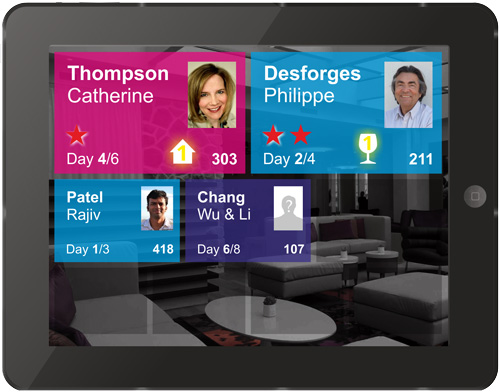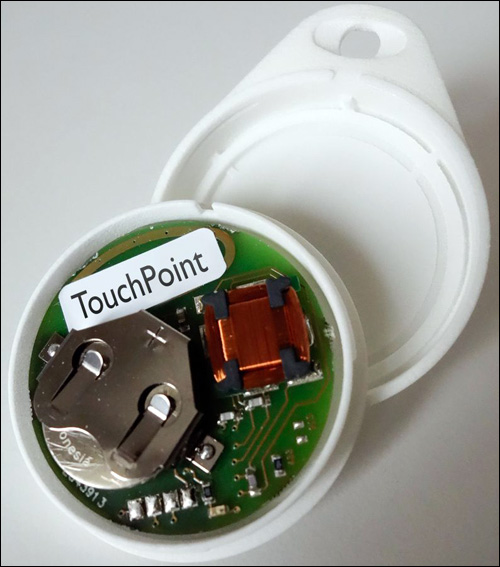When travelers check into a hotel, they might feel more at home if employees at that establishment recognized them by name and treated them as friends. One luxury hotel in the Lake Geneva area of Switzerland is doing just, with help from RFID-based technology. The five-star hotel has installed an RFID system known as TouchPoint, provided by Swiss startup OneLab Solutions, to identify guests as they approach the bar.
Although the hotel has asked to remain unnamed, its director says: “As a five-star hotel, we strive to provide excellent personalized service, but it is difficult to recognize every guest. TouchPoint helps us achieve this, and lets all of our guests feel like a VIP. We are looking forward to extending the system throughout the hotel in order to improve the overall guest experience.”
The system consists of active 433 MHz RFID tags built into key fobs carried by guests, as well as readers that awaken and receive those tags’ transmitted ID numbers, and then forward those IDs back to a gateway, which communicates with a cloud-based server. A tablet computer mounted behind the bar can then display information about the customers carrying the fobs. OneLab charges clients a monthly fee for the software service and use of the hardware.
OneLab was launched in 2012 by four individuals with backgrounds in RFID technology, with the mission of offering security solutions that identify when individuals or objects enter specific areas, according to Skye Legon, one of the cofounders. However, the TouchPoint solution was conceived when the cofounders began considering what their technology could offer the hospitality industry. The initial concept, he says, began with the idea of installing a reader at an elevator to identify a guest and his or her room number. OneLab software would then use that data to direct the elevator to automatically proceed to the individual’s specific floor.
The company met with several hotels and found that instead of automating elevators, the hotels’ primary concern was to make it possible for personnel to simply recognize guests prior to providing them with services. For example, if staff members knew who had entered a restaurant, swimming-pool area or spa, they could greet those guests by name, directly bill services to their rooms and cater to any specific requirements (such as accommodating an allergy to particular foods, or a preference for a certain drink or table) without being asked.
In August of this year, OneLab installed the TouchPoint solution at the Swiss hotel’s bar. When checking into the hotel, a guest now receives a room key with a fob containing a built-in 433 MHz active RFID tag provided by French technology partner Adveez. The tag beacons only when awoken by an exciter, manufactured by the same vendor. Guest services software links the key fob’s unique ID number with the guest’s name and room number, and then shares that information with the TouchPoint software running on the hosted server. Employees working at the reception desk explain how the key fob works to the guest.
Guests who opt not to be recognized via the fob are told they can simply leave the device in their room when visiting the bar. Those who do participate, however, bring the fob with them upon entering the bar, where two readers were installed. When a key fob comes within about 10 feet of the one of the readers, its tag detects a 125 kHz signal emitted by that device. In response, the tag begins beaconing its unique ID to the reader, which then transmits that ID, along with its own, to a gateway unit that forwards the data to the server. The tag read range is set for 10 feet, Legon explains, since that is the typical distance at which eye contact is usually made between a worker and a guest. If the range were longer, he adds, bartenders would capture stray reads of individuals not approaching the bar.

Staff members utilize a tablet computer, mounted behind the bar, to view the name, gender and any unique details about that person, including his or her room number. They can then greet the individual by name.
The TouchPoint system can also be used at an elevator, Legon says, as well as for safety purposes. For example, a reader on each floor could identify every tag present, so that in the event of an emergency, personnel would know exactly how many people were located on that floor, or at another specified location.
OneLab is further developing the software to enable bartenders to update data in the TouchPoint application via the tablet. If a guest orders a specific drink, for example, employees would be able to input that data into the system via the tablet, so that if the individual returned, he or she could be offered the same beverage.
Upon checking out, the hotel guest would simply return the fob, which would eventually be assigned to a new guest. If a reader were installed at a hotel’s entranceway, it could detect if someone who had checked out had inadvertently failed to return his or her key fob and had started to leave the site. The TouchPoint software would then issue an alert to hotel employees, who could quickly stop the guest and remind him or her to turn over the fob. In addition, a hotel could provide loyalty cards with built-in RFID tags that regular patrons could carry so that the registration desk staff could immediately recognize them.
What the hospitality industry needs most, Legon says, “is efficient and personalized service.”
OneLab conducted tests involving a variety of RFID tags before selecting the active 433 MHz solution with a 125 kHz exciter. According to Legon, passive RFID tags were considered too unreliable to be read, and such tags were overly affected by their orientation, as well as where on a person’s body they were being carried. OneLab found that the read ranges of 2.4 GHz active tags were too long, and also varied depending on where on the body the key fob was located (such as in a back pocket, versus in a purse or jacket pocket). The company brought its specifications to Adveez, which adapted its active 433 MHz tags and readers to accommodate the requested use case. OneLab has a patent pending for the full solution.
Adveez specializes in access-control and wander-management solutions for monitoring the elderly using active RFID tags. The use of active RFID technology, says Thibaut Kein, the company’s director of sales and marketing, ensures very accurate location data. “Our detection is precise—which isn’t the case while using common UHF [ultrahigh-frequency] technologies,” he says. “[A] customer is located precisely inside the hotel building.” Several tags, he notes, can be detected simultaneously without the transmissions colliding.



